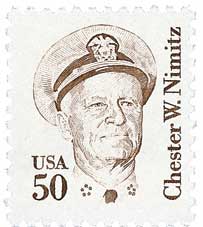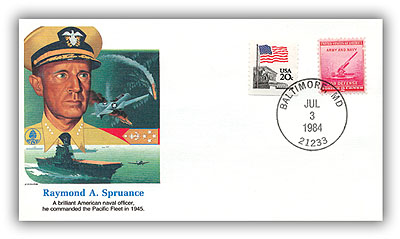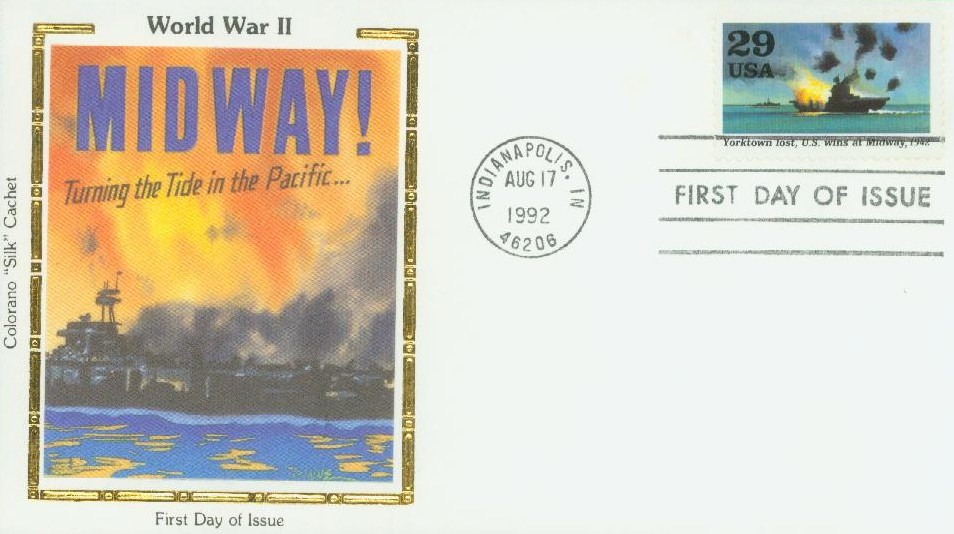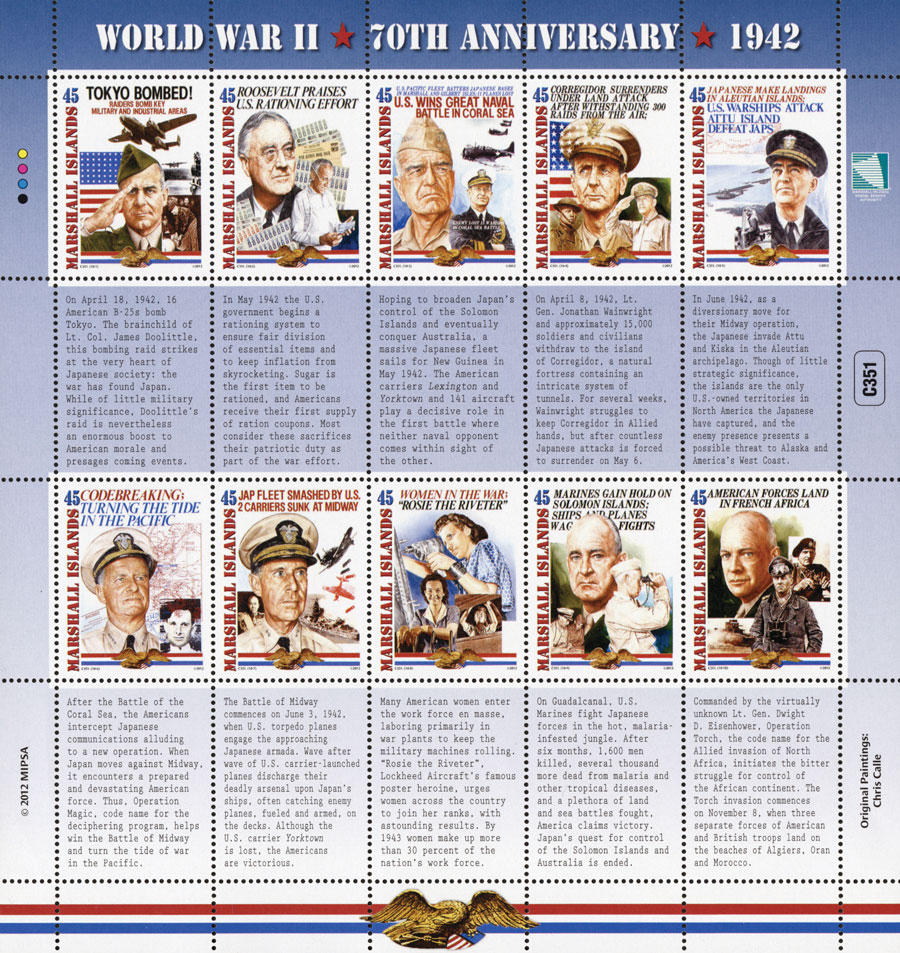
# 2697g - 1992 29c World War II: Yorktown Lost, US Wins at Midway
US #2697g
1992 Yorktown Lost, US Wins Midway, 1942
- Part of the second Souvenir Sheet issued to commemorate 50th anniversary of World War II
- Sheet contains 10 stamps and a world map.
Stamp Category: Commemorative
Set: 1942: Into the Battle, World War II
Value: 29¢ First Class Mail Rate
First Day of Issue: August 17, 1992
First Day City: Indianapolis, Indiana
Quantity Issued: 12,000,000 stamps
Printed by: Bureau of Engraving and Printing
Printing Method: offset/ intaglio
Format: Sheetlets of 10, arranged in two strips of 5 with a world map between. Offset printing plates of 8 sheetlets (2 across, 4 down). Intaglio printing sleeves of 16 sheetlets (2 across, 8 down)
Perforations: 11
Why the stamp was issued: This stamp is part of a sheetlet issued to commemorate the 50th anniversary of World War II. It was the second in a series of five that were issued over the course of five years.
About the stamp design: There were many topics the USPS wanted to cover when commemorating World War II, but those planning the series didn’t want to issue a large number of stamps. It was decided a sheetlet format would best highlight the main events of the war. In order for all the sheetlets to have a uniform design, the same artist, William Bond, and art director, Howard Paine, were assigned to the entire project.
Bond and Paine had a difficult time deciding how to portray code breakers. Bond decided to paint items symbolic of the work of decoding enemy messages. These include a headset, pencil, and lamp. The paper with the decoded message was based on the Purple Code used by the Japanese ambassador to send a note to Tokyo months before the attack on Pearl Harbor.
Special design details: Though the sheet is very similar to the 1991 issue, there are some small changes. In this sheet, the year 1942 was added to each individual stamp. The previous sheet only had the year on the map, so if the stamps were separated it would have been difficult to identify the year the stamp was commemorating. In addition, an explanation was added to the map which read, “Red areas controlled by enemy.”
First Day City: The First Day of Issue ceremony took place at the national convention of the Veterans of Foreign Wars of the United States, which took place in Indianapolis, Indiana.
About the World War II Series: As the 50th anniversary of World War II was approaching the US Postal Service wanted a series that would recognize the key events of the war and the important contributions America made to the Allied victory. Rather than issue a large number of stamps, the USPS decided to create five sheetlets, each commemorating one year of America’s involvement in the war. Each sheetlet had 10 different stamps arraigned in two horizontal strips of 5. In the center was a world map with Allied and neutral nations in yellow and Axis-controlled areas in red. Notes on the map highlighted key developments that occurred that year. The stamps each featured important events that took place during the year, as well.
History the stamp represents:
In early June 1942, Japanese Admiral Isoroku Yamamoto planned to seize the island of Midway. US code breakers discovered the plan, including location and dates. In response, three American aircraft carriers were sent to the location to confront the four Japanese carriers headed to Midway. During the battle, all four Japanese ships were sunk. The US lost the carrier Yorktown. This Allied victory is considered a turning point of the war on the Pacific.
Allies Win Battle Of Midway
Shortly after the attack on Pearl Harbor in December 1941, the Japanese began mapping out a plan to take down America’s carrier forces. Realizing Pearl Harbor was now too well defended, they set their sights northwest on Midway Island, at the end of the Hawaiian Island chain.

Although they had naval superiority over the US and were essentially able to attack as they pleased, the Doolittle Raids on Tokyo and several other major cities had damaged the Japanese psychologically months earlier.
The Japanese plan was to disperse their ships around the area, hidden from American view. They hoped to lure US aircraft carriers into a deadly ambush near the Midway atoll and eliminate the US presence in the Pacific Ocean. With that accomplished, Admiral Isoroku Yamamoto planned to invade the Atoll’s small islands and establish a Japanese air base there. However, Yamamoto’s plans were thwarted when the Imperial Navy’s JN-25 code was cracked and plans for the raid were discovered in mid-May.
In addition to knowing where and when the attack was planned, American Admiral Chester Nimitz knew the battle order. Another part of the Japanese plan that weighed against them was the fact that the ships were too far dispersed and were never able to aid the ships that were engaged in battle.

Expecting the Japanese to send four or five carriers into battle, Admiral Nimitz ordered every available US flight deck to make its way to Midway. By June 3, 1942, he had three carriers and a total of 124 aircraft ready and waiting for battle. The American forces sent out their first planes at 12:30 p.m. on June 3. Though they dropped bombs on the Japanese ships, they failed to inflict any damage.
The following morning, June 4, 1942, the Americans again sent out planes, this time striking a Japanese oil tanker. The Japanese then retaliated, attacking the island itself.

American torpedo bombers then drew Japanese fighters away from their ships, allowing dive-bombers from the Enterprise and Yorktown to take out three Japanese vessels. The destruction of the fourth Japanese ship later that afternoon forced their retreat. Though they managed to sink the Yorktown before dispersing. The last air attacks of the battle took place on June 6, when Douglas SBD Dauntless dive-bombers from the Hornet and Enterprise bombed and sunk the Japanese heavy cruiser Mikuma. American forces attempted to salvage the Yorktown into June 7, but when it was deemed impossible, efforts ended and so did the battle.

Despite a three-to-one disadvantage in ships and aircraft, the US was able to inflict huge damages against the Japanese Navy, and force its retreat. Three days of intense fighting and lightning raids led to the sinking of four Japanese fleet carriers. Victory allowed the US to control Midway for the rest of the war. One historian called it “the most stunning and decisive blow in the history of naval warfare.”
Click here to view photos and maps of the Battle of Midway.
US #2697g
1992 Yorktown Lost, US Wins Midway, 1942
- Part of the second Souvenir Sheet issued to commemorate 50th anniversary of World War II
- Sheet contains 10 stamps and a world map.
Stamp Category: Commemorative
Set: 1942: Into the Battle, World War II
Value: 29¢ First Class Mail Rate
First Day of Issue: August 17, 1992
First Day City: Indianapolis, Indiana
Quantity Issued: 12,000,000 stamps
Printed by: Bureau of Engraving and Printing
Printing Method: offset/ intaglio
Format: Sheetlets of 10, arranged in two strips of 5 with a world map between. Offset printing plates of 8 sheetlets (2 across, 4 down). Intaglio printing sleeves of 16 sheetlets (2 across, 8 down)
Perforations: 11
Why the stamp was issued: This stamp is part of a sheetlet issued to commemorate the 50th anniversary of World War II. It was the second in a series of five that were issued over the course of five years.
About the stamp design: There were many topics the USPS wanted to cover when commemorating World War II, but those planning the series didn’t want to issue a large number of stamps. It was decided a sheetlet format would best highlight the main events of the war. In order for all the sheetlets to have a uniform design, the same artist, William Bond, and art director, Howard Paine, were assigned to the entire project.
Bond and Paine had a difficult time deciding how to portray code breakers. Bond decided to paint items symbolic of the work of decoding enemy messages. These include a headset, pencil, and lamp. The paper with the decoded message was based on the Purple Code used by the Japanese ambassador to send a note to Tokyo months before the attack on Pearl Harbor.
Special design details: Though the sheet is very similar to the 1991 issue, there are some small changes. In this sheet, the year 1942 was added to each individual stamp. The previous sheet only had the year on the map, so if the stamps were separated it would have been difficult to identify the year the stamp was commemorating. In addition, an explanation was added to the map which read, “Red areas controlled by enemy.”
First Day City: The First Day of Issue ceremony took place at the national convention of the Veterans of Foreign Wars of the United States, which took place in Indianapolis, Indiana.
About the World War II Series: As the 50th anniversary of World War II was approaching the US Postal Service wanted a series that would recognize the key events of the war and the important contributions America made to the Allied victory. Rather than issue a large number of stamps, the USPS decided to create five sheetlets, each commemorating one year of America’s involvement in the war. Each sheetlet had 10 different stamps arraigned in two horizontal strips of 5. In the center was a world map with Allied and neutral nations in yellow and Axis-controlled areas in red. Notes on the map highlighted key developments that occurred that year. The stamps each featured important events that took place during the year, as well.
History the stamp represents:
In early June 1942, Japanese Admiral Isoroku Yamamoto planned to seize the island of Midway. US code breakers discovered the plan, including location and dates. In response, three American aircraft carriers were sent to the location to confront the four Japanese carriers headed to Midway. During the battle, all four Japanese ships were sunk. The US lost the carrier Yorktown. This Allied victory is considered a turning point of the war on the Pacific.
Allies Win Battle Of Midway
Shortly after the attack on Pearl Harbor in December 1941, the Japanese began mapping out a plan to take down America’s carrier forces. Realizing Pearl Harbor was now too well defended, they set their sights northwest on Midway Island, at the end of the Hawaiian Island chain.

Although they had naval superiority over the US and were essentially able to attack as they pleased, the Doolittle Raids on Tokyo and several other major cities had damaged the Japanese psychologically months earlier.
The Japanese plan was to disperse their ships around the area, hidden from American view. They hoped to lure US aircraft carriers into a deadly ambush near the Midway atoll and eliminate the US presence in the Pacific Ocean. With that accomplished, Admiral Isoroku Yamamoto planned to invade the Atoll’s small islands and establish a Japanese air base there. However, Yamamoto’s plans were thwarted when the Imperial Navy’s JN-25 code was cracked and plans for the raid were discovered in mid-May.
In addition to knowing where and when the attack was planned, American Admiral Chester Nimitz knew the battle order. Another part of the Japanese plan that weighed against them was the fact that the ships were too far dispersed and were never able to aid the ships that were engaged in battle.

Expecting the Japanese to send four or five carriers into battle, Admiral Nimitz ordered every available US flight deck to make its way to Midway. By June 3, 1942, he had three carriers and a total of 124 aircraft ready and waiting for battle. The American forces sent out their first planes at 12:30 p.m. on June 3. Though they dropped bombs on the Japanese ships, they failed to inflict any damage.
The following morning, June 4, 1942, the Americans again sent out planes, this time striking a Japanese oil tanker. The Japanese then retaliated, attacking the island itself.

American torpedo bombers then drew Japanese fighters away from their ships, allowing dive-bombers from the Enterprise and Yorktown to take out three Japanese vessels. The destruction of the fourth Japanese ship later that afternoon forced their retreat. Though they managed to sink the Yorktown before dispersing. The last air attacks of the battle took place on June 6, when Douglas SBD Dauntless dive-bombers from the Hornet and Enterprise bombed and sunk the Japanese heavy cruiser Mikuma. American forces attempted to salvage the Yorktown into June 7, but when it was deemed impossible, efforts ended and so did the battle.

Despite a three-to-one disadvantage in ships and aircraft, the US was able to inflict huge damages against the Japanese Navy, and force its retreat. Three days of intense fighting and lightning raids led to the sinking of four Japanese fleet carriers. Victory allowed the US to control Midway for the rest of the war. One historian called it “the most stunning and decisive blow in the history of naval warfare.”
Click here to view photos and maps of the Battle of Midway.










